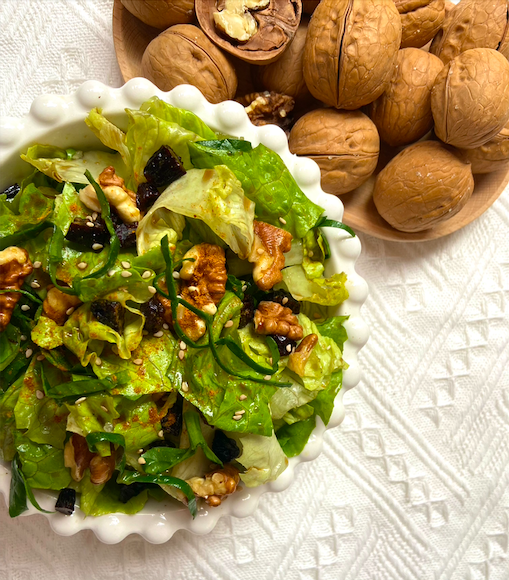Have you ever tried homemade vinaigrette salad dressing? Making a homemade vinaigrette is much easier than you think, and you can customize your vinaigrette and salad based on your favorite flavors. This vinaigrette contains much less sodium than store-bought salad dressing. Individuals with certain chronic conditions, such as high blood pressure, heart disease, and kidney disease are recommended to maintain a low sodium diet [i]. This recipe is also high in dietary fiber from the salad greens and omega-3 fatty acids from the walnuts.
Ingredient Highlights
Greens and walnuts are a great source of dietary fiber. Dietary fiber is associated with decreased risk of cardiovascular diseases (CVD) [ii].
This recipe uses curry powder to season the vinaigrette rather than salt, to minimize sodium consumption. Curry powder is a mixture of spices that usually consist of ginger, garlic, and turmeric, and is used in many different cuisines around the world. One key ingredient, turmeric, contains the pigment curcumin, which has anti-inflammatory properties. Several studies have indicated that curcumin may provide benefits for inflammatory conditions [iii]. The American Heart Association (AHA) recommends no more than 2300 mg of sodium per day and an ideal limit of less than 1500 mg of sodium per day for adults [iv]. High sodium consumption can raise blood pressure, which is one of the significant risk factors for CVD [v].
Walnuts provide omega-3 fatty acids that are essential for good health. The human body cannot self-produce omega-3 fatty acids. Omega-3 fatty acids play a crucial role in decreasing the inflammatory processes of chronic diseases, such as cardiovascular diseases, inflammatory bowel disease, cancer, and rheumatoid arthritis [vi].
Recipe
Curried Balsamic Vinaigrette with Walnut Salad
Yield: 2 servings
Serving Size: 2 cups

Ingredients
- 2 Tbsp balsamic vinegar
- 2 tsp curry powder
- 1 Tbsp brown sugar
- 1 Tbsp olive oil
- 4 cups salad greens
- 2 Tbsp walnuts, chopped
- 1 Tbsp pine nuts
- 1 Tbsp raisins, chopped
- 2 tsp sesame seeds
Instructions
1. In a small container for sauce, whisk together the balsamic vinegar, curry powder, and brown sugar. Slowly combine olive oil to the mixture until emulsified.
2. Place all salad greens in a large mixing bowl. Place chopped walnuts, pine nuts, and raisins into the greens. Add vinaigrette to moisten.
3. Divide the salad into two plates or bowls; sprinkle with sesame seeds on top of the salads and serve immediately if desired.
Tips:
- Customize your salad with your favorite vegetables, fruits, herbs, and spices.
- There are many other ways to minimize sodium intake in vinaigrette other than curry powder. For example, add fruit or vegetable juice, such as orange juice, cucumber juice, or passion fruit juice.
- To clean salad greens, first soak the greens in a large container with cold water and gently swish them around for 30 seconds. Drain the water and rinse any soil from the container. Rinse and wash with cold water a second time to ensure no soil on the greens.
- To store salad greens properly, use a salad spinner to remove the moisture on the greens or use a paper towel. Place dry greens in a clean plastic bag with a dry paper towel inside and store in the refrigerator.
Nutrition Information per serving (2 cups)
| Calories | 242 kcal |
| Carbohydrate | 16 g |
| Protein | 5 g |
| Fat | 17 g |
| Fiber | 6 g |
| Mg per serving size | DRI (Dietary Reference Intake) | |
| Sodium | 54 mg | 3.5% |
| Phosphorus | 164 mg | 12% |
| Potassium | 1171.9 mg | 23% |
References:
[i] Salt reduction. Word Health Organization. Retrieved from https://www.who.int/news-room/fact-sheets/detail/salt-reduction
[ii] Soliman GA. Dietary Fiber, Atherosclerosis, and Cardiovascular Disease. Nutrients. 2019;11(5):1155. Published 2019 May 23. doi:10.3390/nu11051155
[iii] Jurenka JS. Anti-inflammatory properties of curcumin, a major constituent of Curcuma longa: a review of preclinical and clinical research [published correction appears in Altern Med Rev. 2009 Sep;14(3):277]. Altern Med Rev. 2009;14(2):141-153.
[vi] How much sodium should I eat per day? America Heart Association. Retrieved from https://www.heart.org/en/healthy-living/healthy-eating/eat-smart/sodium/how-much-sodium-should-i-eat-per-day
[v] National Academies of Sciences, Engineering, and Medicine 2019. Dietary Reference Intakes for Sodium and Potassium. Washington, DC: The National Academies Press. https://doi.org/10.17226/25353.
[vi] Rebecca Wall, R Paul Ross, Gerald F Fitzgerald, Catherine Stanton, Fatty acids from fish: the anti-inflammatory potential of long-chain omega-3 fatty acids, Nutrition Reviews, Volume 68, Issue 5, 1 May 2010, Pages 280–289, https://doi.org/10.1111/j.1753-4887.2010.00287.x
